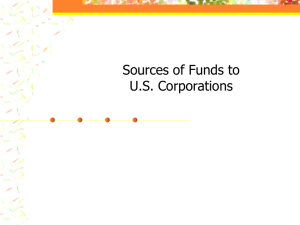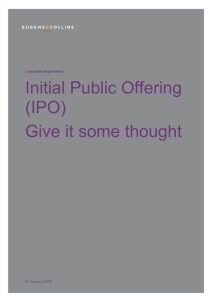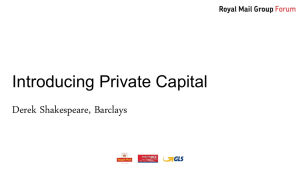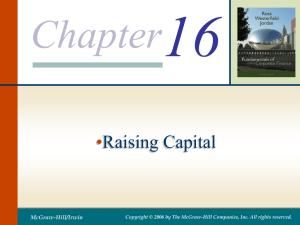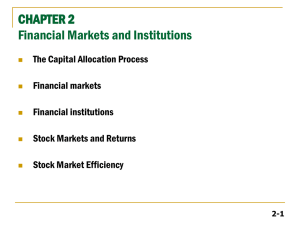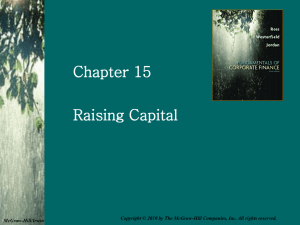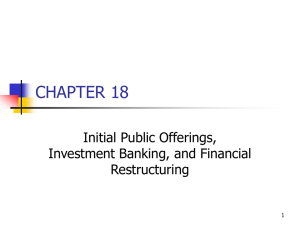ppt
advertisement
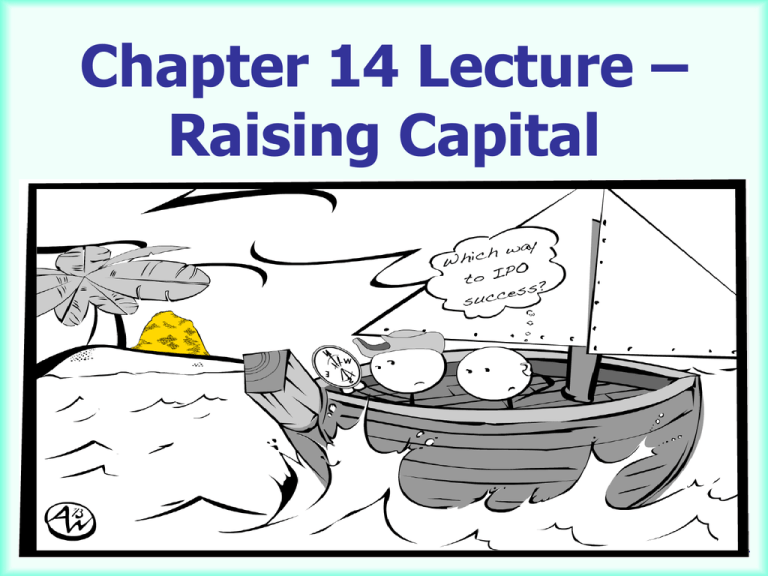
Chapter 14 Lecture – Raising Capital 15-1 14-1 Learning Objectives After studying this chapter, you should be able to: LO1 Explain the venture capital market and its role in the financing of new, high-risk ventures. LO2 Describe how securities are sold to the public and the role of investment banks in the process. LO3 Explain initial public offerings and identify some of the costs of going public. 14-2 Venture Capital “Private Equity” Private financing for new, high risk businesses in exchange for stock Individual investors Venture capital firms Usually involves active participation by VC Ultimate goal: take company public; the VC will benefit from the capital raised in the IPO Hard to find Expensive 14-3 Venture Capital Stage Financing Funding provided in several stages Contingent upon specified goals at each stage First stage “Ground floor” or “Seed money” Fund prototype and manufacturing plan Second Stage “Mezzanine” financing Begin manufacturing, marketing & distribution Choosing a Venture Capitalist Financial strength Compatible management style Obtain and check references Contacts Exit strategy 14-4 Selling Securities to the Public 1. 2. 3. 4. 5. 6. Management obtains permission from the Board of Directors Firm files a registration statement with the SEC SEC examines the registration during a 20-day waiting period Securities may not be sold during the waiting period A preliminary prospectus, called a red herring, is distributed during the waiting period - If problems, the company amends the registration, and the waiting period starts over Price per share determined on the effective date of the registration and the selling effort begins 14-5 Issue Methods Public Issue Registration with SEC required General cash offer = offered to general public Rights offer = offered only to current shareholders IPO = Initial Public Offering = Unseasoned new issue SEO = Seasoned Equity Offering Private Issue Sold to fewer than 35 investors SEC registration not required 14-6 Methods of Issuing New Securities 14-7 Underwriters Underwriting services: Formulate method to issue securities Price the securities Sell the securities Price stabilization by lead underwriter in the aftermarket Syndicate = group of investment bankers that market the securities and share the risk associated with selling the issue Spread = difference between what the syndicate pays the company and what the security sells for in the market 14-8 Tombstone • Investment banks in syndicate divided into brackets • Firms listed alphabetically within each bracket • “Pecking order” • Higher bracket = greater prestige http://usequities.nyx.com/ipo-center/recent-ipo • Underwriting success built on reputation http://www.renaissancecapital.com/ipohome/press/ipofilings.aspx 14-9 Firm Commitment Underwriting Issuer sells entire issue to underwriting syndicate Syndicate resells issue to the public Underwriter makes money on the spread between the price paid to the issuer and the price received from investors when the stock is sold Syndicate bears the risk of not being able to sell the entire issue for more than the cost Most common type of underwriting in the United States 14-10 Best Efforts Underwriting Underwriter makes “best effort” to sell the securities at an agreed-upon offering price Issuing company bears the risk of the issue not being sold Offer may be pulled if not enough interest at the offer price Company does not get the capital and they have still incurred substantial flotation costs Not as common as it used to be 14-11 Dutch or Uniform Price Auction Buyers: •Bid a price and number of shares Seller: •Work down the list of bidders •Determine the highest price at which they can sell the desired number of shares • All successful bidders pay the same price per share. • Encourages aggressive bidding 14-12 Dutch or Uniform Price Auction Example The company wants to sell 1,500 shares of stock. Bidder A B C D E Quantity 500 400 250 350 200 Bid $20 18 16 15 12 The firm will sell 1,500 shares at $15 per share. Bidders A, B, C, and D will get shares. Bidder A B C D E Quantity 500 400 250 350 200 Bid $20 18 16 15 12 Σ Qty 500 900 1,150 1,500 1,700 14-13 Green Shoe Provision “Overallotment Option” Allows syndicate to purchase an additional 15% of the issue from the issuer Allows the issue to be oversubscribed Provides some protection for the lead underwriter as they perform their price stabilization function In all IPO and SEO offerings but not in ordinary debt offerings Lockup Agreements Not legally required but common Restricts insiders from selling IPO shares for a specified time period Common lockup period = 180 days Stock price tends to drop when the lockup period expires due to market anticipation of additional shares hitting the Street 14-14 IPO Underpricing IPO pricing = very difficult No current market price available Dutch Auctions designed to eliminate first day IPO price “pop” Underpricing causes the issuer to “leave money on the table” Degree of underpricing varies over time 14-15 The Partial Adjustment Phenomenon During SEC registration, a company will set a “file price range” Just before the IPO, the final price is determined The final price can be below, inside, or above the file price range Historically, IPOs with a final price above the file range have been far more underpriced than those with a final price below or inside the file range 14-16 IPO Underpricing Reasons Underwriters want offerings to sell out Reputation for successful IPOs is critical Underpricing = insurance for underwriters Oversubscription & allotment “Winner’s Curse” Smaller, riskier IPOs underprice to attract investors 14-17 Seasoned Equity Offerings Stock prices tend to decline when new equity is issued Signaling explanations: Equity overvalued: If management believes equity is overvalued, they would choose to issue stock shares Debt usage: Issuing stock may indicate firm has too much debt and can not issue more debt Issue costs Issue costs for equity – direct and indirect - are significantly more than for debt 14-18 The Cost of Issuing Securities 14-19 The Cost of Issuing Securities Average total direct costs ≈ 10.4% Largest direct cost, gross spread average ≈ 7.2% Direct costs very large, especially for issues < $10 million (25.22%) Underpricing cost ≈ 19.3% Patterns: Substantial economies of scale Costs of selling debt < issuing equity IPO costs > SEO costs Straight bonds < Convertible bonds 14-20 IPO Cost – Example The Faulk Co. has just gone public under a firm commitment agreement. Faulk received $32 for each of the 4.1 million shares sold. The initial offering price was $34.40 per share, and the stock rose to $41 per share in the first few minutes of trading. Faulk paid $905,000 in legal and other direct costs and $250,000 in indirect costs. What was the flotation cost as a percentage of funds raised? The net amount raised is the number of shares offered times the price received by the company, minus the costs associated with the offer, so: Net amount raised = (4,100,000 shares)($32) – 905,000 – 250,000 = $130,045,000 14-21 IPO Cost – Example Next, we can calculate the direct costs. Part of the direct costs are given in the problem, but the company also had to pay the underwriters. The stock was offered at $34.40 per share, and the company received $32 per share. The difference, which is the underwriters’ spread, is also a direct cost. Total direct costs = $905,000 + ($34.40 – 32)(4,100,000 shares) = $10,745,000 We are given part of the indirect costs, but the underpricing is another indirect cost. Total indirect costs = $250,000 + ($41 – 34.40)(4,100,000 shares) = $27,310,000 14-22 IPO Cost – Example Total costs = $10,745,000 + 27,310,000 = $38,055,000 The flotation costs as a percentage of the amount raised is the total cost divided by the amount raised, or: Flotation cost percentage = $38,055,000 / $130,045,000 Flotation cost percentage = .2926, or 29.26% 14-23 Types of Long-term Debt Bonds – public issue of long-term debt Private issues Term loans Private placements Direct business loans from commercial banks, insurance companies, etc. Maturities 1 – 5 years Repayable during the life of the loan Similar to term loans with longer maturity Easier to renegotiate than public issues Lower costs than public issues No SEC registration 14-24 Shelf Registration SEC Rule 415 Permits firm to register a large issue with the SEC and sell it in small portions Reduces flotation costs Allows company more flexibility to raise money quickly Requirements Company must be rated investment grade Cannot have defaulted on debt within last three years Market value of stock must be greater than $150 million No violations of the Securities Act of 1934 in the preceding three years 14-25 What Agencies Regulate Securities Markets? The Securities and Exchange Commission (SEC) regulates: Interstate public offerings. National stock exchanges. Trading by corporate insiders. The corporate proxy process. The Federal Reserve Board controls margin requirements. States control the issuance of securities within their boundaries. The securities industry, through the exchanges and the National Association of Securities Dealers (NASD), takes actions to ensure the integrity and credibility of the trading 26 system. What about Qatar? 14-26 How are Start-up Firms Unusually Financed? Founder’s resources Angels Venture capital funds Most capital in fund is provided by institutional investors Managers of fund are called venture capitalists Venture capitalists (VCs) sit on boards of companies they fund 14-27 Differentiate Between a Private Placement and a Public Offering In a private placement, such as to angels or VCs, securities are sold to a few investors rather than to the public at large. In a public offering, securities are offered to the public and must be registered with SEC. Privately placed stock is not registered, so sales must be to “accredited” (high net worth) investors. Send out “offering memorandum” with 20-30 pages of data and information, prepared by securities lawyers. Buyers certify that they meet net worth/income requirements and they will not sell to unqualified investors. 14-28 Why Would a Company Consider Going Public? Advantages of going public Current stockholders can diversify. Liquidity is increased. Easier to raise capital in the future. Going public establishes firm value. Makes it more feasible to use stock as employee incentives. Increases customer recognition. 14-29 Disadvantages of Going Public Must file numerous reports. Operating data must be disclosed. Officers must disclose holdings. Special “deals” to insiders will be more difficult to undertake. A small new issue may not be actively traded, so market-determined price may not reflect true value. Managing investor relations is timeconsuming. 14-30 What are the Steps of an IPO? Select investment banker Reputation and experience in this industry Existing mix of institutional and retail (i.e., individual) clients Support in the post-IPO secondary market Reputation of analyst covering the stock File registration document (S-1) with SEC Choose price range for preliminary (or “red herring”) prospectus Go on roadshow Set final offer price in final prospectus 14-31 Would Companies Going Public Use a Negotiated Deal or a Competitive Bid? A negotiated deal. The competitive bid process is only feasible for large issues by major firms. Even here, the use of bids is rare for equity issues. It would cost investment bankers too much to learn enough about the company to make an intelligent bid. 14-32 What Would the Sale be on an Underwritten or Best Efforts Basis? Most offerings are underwritten. In very small, risky deals, the investment banker may insist on a best efforts basis. On an underwritten deal, the price is not set until Investor interest is assessed. Oral commitments are obtained. 14-33 How an IPO Would be Priced Since the firm is going public, there is no established price. Banker and company project the company’s future earnings and free cash flows The banker would examine market data on similar companies. Price set to place the firm’s P/E and M/B ratios in line with publicly traded firms in the same industry having similar risk and growth prospects. On the basis of all relevant factors, the investment banker would determine a ballpark price, and specify a range (such as $10 to $12) in the preliminary prospectus. 14-34 What is a Roadshow? Senior management team, investment banker, and lawyer visit potential institutional investors Usually travel to ten to twenty cities in a two-week period, making three to five presentations each day. Management can’t say anything that is not in prospectus, because company is in “quiet period.” What is “Book Building?” Investment banker asks investors to indicate how many shares they plan to buy, and records this in a “book”. Investment banker hopes for oversubscribed issue. Based on demand, investment banker sets final offer price on evening before IPO. 14-35 What are Typical First-day Returns? For 75% of IPOs, price goes up on first day. Average first-day return is 14.1%. About 10% of IPOs have first-day returns greater than 30%. For some companies, the first-day return is well over 100%. There is an inherent conflict of interest, because the banker has an incentive to set a low price: to make brokerage customers happy. to make it easy to sell the issue. Firm would like price to be high. Note that original owners generally sell only a small part of their stock, so if price increases, they benefit. Later offerings easier if first goes well 14-36 What are the Long-term Returns to Investors in IPOs? Two-year return following IPO is lower than for comparable non-IPO firms. On average, the IPO offer price is too low, and the first-day run-up is too high. 14-37 What are the Direct Costs of an IPO? Underwriter usually charges a 7% spread between offer price and proceeds to issuer. Direct costs to lawyers, printers, accountants, etc. can be over $400,000. What are the Indirect costs of an IPO? Money left on the table (End of price on first day - Offer price) x Num If firm issues 7 million shares at $10, what are net proceeds if spread is 7%? Gross proceeds = 7 x $10 million = $70 million Underwriting fee = 7% x $70 million = $4.9 million Net proceeds = $70 - $4.9 14-38 If firm issues 7 million shares at $10, what are net proceeds if spread is 7%? Gross proceeds = 7 x $10 million = $70 million Underwriting fee = 7% x $70 million = $4.9 million Net proceeds = $70 - $4.9 = $65.1 million 14-39 What are equity carve-outs? A special IPO in which a parent company creates a new public company by selling stock in a subsidiary to outside investors. Parent usually retains controlling interest in new public company. What is a rights offering? A rights offering occurs when current shareholders get the first right to buy new shares. Shareholders can either exercise the right and buy new shares, or sell the right 40 to someone else. Wealth of shareholders doesn’t change whether they exercise right or sell it. 14-40 What is meant by going private? Going private is the reverse of going public. Typically, the firm’s managers team up with a small group of outside investors and purchase all of the publicly held shares of the firm. The new equity holders usually use a large amount of debt financing, so such transactions are called leveraged buyouts (LBOs). 41 14-41 Real world IPOs 42 14-42 Advantages of going private Gives managers greater incentives and more flexibility in running the company. Removes pressure to report high earnings in the short run. After several years as a private firm, owners typically go public again. Firm is presumably operating more efficiently and sells for more. Disadvantages of going private Firms that have recently gone private are normally leveraged to the hilt, so it’s 43difficult to raise new capital. A difficult period that normally could be weathered might bankrupt the company. 14-43 firm exercise a bond call provision? If interest rates have fallen since the bond was issued, the firm can replace the current issue with a new, lower coupon rate bond. However, there are costs involved in refunding a bond issue. For example, The call premium. Flotation costs on the new issue. The NPV of refunding compares the interest savings benefit with the costs of the refunding. A positive NPV indicates that refunding today would increase the value of the firm. 44 However, it interest rates are expected to fall further, it may be better to delay refunding until some time in the future. 14-44 Managing debt risk with project financing Project financings are used to finance a specific large capital project. Sponsors provide the equity capital, while the rest of the project’s capital is supplied by lenders and/or lessors. Interest is paid from project’s cash flows, and borrowers don’t have recourse. 45 14-45 Managing debt risk with securitization Securitization is the process whereby financial instruments that were previously illiquid are converted to a form that creates greater liquidity. Examples are bonds backed by mortgages, auto loans, credit card loans (asset-backed), and so on. 46 14-46
